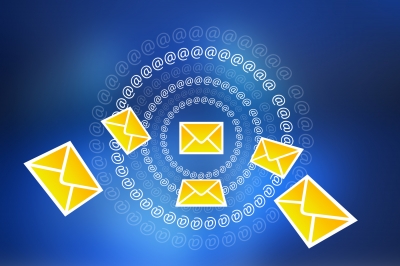Who Should Manage Your Small Business Email Newsletter?

Image courtesy of Stuart Miles / FreeDigitalPhotos.net
Running a small business email newsletter campaign can be challenging as there are several responsibilities other than simply clicking send for each marketing message. That is why some businesses outsource their email marketing to services which specialise in this style of marketing.
For some, outsourcing is not an option and instead they have to manage the email marketing in-house. There is also the option of going hybrid and having some of the email marketing handled by a service provider and some in-house. Here is a breakdown of each option, their advantages and disadvantages and how you can get the most out of each method to generate your email marketing content.
Fully In-house
In-house development of your email marketing campaign certainly has its benefits. The fact that you have someone on the inside of your business creating and sending out your mail allows you to maintain your brand’s voice and therefore your entire marketing is aligned! This can often be a factor in the long term success of conversions. This method can also offer substantial savings, yet that doesn’t always mean cost effectiveness.
On the other hand, there are problems. Unless you hire someone to maintain your email marketing full time then you are going to be doing the work yourself or have a member of your staff do it who has other responsibilities. This can cause problems in busy times when they don’t have the necessary time to offer proper maintenance of the email list.
This can result in missing email deadlines, something which could lead to the loss of email subscribers.
Another issue is that your staff member may not be the best writer, email designer or have another key skill missing. Any of these can affect the quality of your email and therefore cut your conversion rate down.
If you do go down this path it is important that you do several things to ensure the best quality:
1. Hire someone who has experience in writing sales / brand messaging.
2. Give the individual the time to complete their email marketing responsibilities. This may mean taking them off other responsibilities at email release times.
Outsourcing
Outsourcing is a good option for those who know that they don’t have the time or expertise to manage their email marketing. Top quality content can be written, delivered and monitored for a price which is suitable for your business. This can allow you and your team to concentrate on what you do best – providing your service to your customers.
Yet there are risks when going down this route. Firstly you have to ensure that the provider is legitimate. If the provider has a bad record online then your emails are going to be sent to spam folders. Also they might be able to send the emails, but they might not be able to write them or capture your brand’s voice.
Any of these problems occurring could mean your contacts question your professionalism, and you may lose subscribers and conversions.
Yet this method can offer a vital component to the marketing, statistics. Statistics allow you to fine-tune your marketing and find out what’s successful and what isn’t. If you don’t know how to monitor your email statistics this might be a good option.
To make outsourcing work, ensure the following:
1. You see examples of work for previous clients of the outsourcing company.
2. You are put into contact with previous clients to speak to them about how they found the service.
3. You add yourself onto the subscriber list to make sure emails are being delivered properly. Sometimes it is best to add you and three or four of your team members as well.
Hybrid Service
Having a hybrid service may be your best option. This is where you are outsourcing what you cannot do and completing the tasks which you are able to manage. You might want to outsource the sending and analysis of the results or the content writing.
This method can be more expensive than that of in-house email marketing, but it can offer you more control while maintaining high standards. Ensure however that you have an effective workflow when you have different individuals working on the various elements of the email campaign to guarantee meeting deadlines.
Conclusion
Email marketing is one of the most effective online marketing methods. It is also a massive undertaking for anyone, let alone a small business team that may be pressed for time. Ensure you are doing the best for your business and consider the options above to make your small business email marketing a success.
Take Action:
- Make a decision on whether you want to have your small business email managed in-house, out of house or by mixing the two options.
Read post Post a Comment. Tagged in: email marketing, Email Newsletters, Email Strategy, Online Marketing, Small Business
How To Use Current Events From LinkedIn To Create Email Content
 Using current events in your marketing mix is an excellent method of developing content which will resonate with your audience. Current events are more likely to attract the attention of your audience and encourage them to read your emails.
Using current events in your marketing mix is an excellent method of developing content which will resonate with your audience. Current events are more likely to attract the attention of your audience and encourage them to read your emails.
‘Events’ don’t have to be about the latest news. It could be covering the most recent trends or the latest problems which your target audience are experiencing at the time.
Discovering what the current issues, trends or news is in your industry are, can be difficult in this fast moving world.
However there is an excellent tool out there which can support your content generation: LinkedIn.
LinkedIn Groups
LinkedIn is one of the best places to find content because part of the social media platform is essentially like a forum where users discuss what issues are affecting them. By joining these groups you can discover what is currently affecting their lives.
You may also be able to get some ideas for your content through direct messaging or through shared articles.
From there you could make a list of topics and do research on how you can solve those problems.
Quoting
If you are particularly social in the groups which you are a member of, you could contact those who have made interesting comments and request permission to use their words in your content. This could be particularly useful as a quoted comment in your content has more authority than if you simply write the text as if it is all from you.
This is also another method of marketing your brand and perhaps having more signatories to your email newsletter and perhaps someone else who is willing to share your newsletter across their social media profiles because you have mentioned them.
Research
Another benefit of finding topics for discussion through LinkedIn is that the audience have probably already completed a lot of research for you. You should take what the group say with a pinch of salt, but there is a chance they would have shared articles or news items which back up what they say – therefore you can spend less time in researching the topic and give your content more authority.
You should include links to this research in your email marketing so your readers can see where you have collected the information from.
The Content
This style of email newsletter suits businesses which like to give very informative and highly valuable content. Essentially, the newsletter is a demonstration of your skills and expertise, offering a preview of the support or solutions you can provide your customers.
In your email you should ensure a story is told. There should be a set up of the problem, the solution and an idea which the audience can action themselves.
Make sure your audience can share the content socially with social media buttons and there is a link to either similar content on your blog or a related blog.
Further Benefits
If you post old versions of your email newsletters online, you can benefit additionally from the content because it is likely people will be using search engines to find articles on the topic you have written about. A good email should have a keyword density which can be easily indexed by the search engines on your website.
Conclusion
LinkedIn can be a fantastic resource for reaching out to your customer base, as long as you use the information it provides to its full potential. The information it can provide is reliable, timely and relevant to your audience and therefore they will enjoy reading and interacting with your email content.
Take Action:
- Have a look on LinkedIn and use some of the conversations you read for your next email newsletter
Do you use social media for conversation generation?
Let us know in the comments below.
“Image courtesy of cooldesigns / FreeDigitalPhotos.net”
Read post Post a Comment. Tagged in: email marketing, Email Newsletters, Email Strategy, LinkedIn, Social Media
When Should You Remove Subscribers From Your Email List?

How long until you delete old mailing contacts
The question is often asked of when you should remove members off your email marketing list. It is an interesting question.
Email marketing lists are sometimes viewed with pride by the number of addresses you have. This has at times led to business leaders going out and buying email lists. There are many articles out there that will advise against this. A bought list can ruin your marketing opportunity as your mail will get reported as spam, be blocked and essentially your reputation will be hurt.
Although old subscribers are unlikely to report your mail as spam – they are a potential problem. Having too many contacts on your database can slow down the delivery rate of your emails to those who are interested in hearing from you and generally no matter which service you use – more email recipients will often mean more money.
Also a group of people with inactive accounts or who simply delete everything in their email inbox will distort your statistics. This will make it harder for you to determine whether or not your campaigns are working.
So to save costs and be more efficient in your email campaigns you should enforce a strict removal policy. But the question is open as to how long you should wait until you remove someone from your mailing list.
There are many points of view on this but there are probably a few key activities (or lack thereof) which should be good indicators to show when you should do this:
1. They’ve requested it
Sometimes people don’t realise that they can simply click on an unsubscribe button on your email to remove their names from your emailing list or something has gone wrong before and it didn’t work.
Therefore, if someone does send you an email requesting that you remove them from your list – the person in charge of the list should do so immediately.
2. You’ve been in regular contact with them before
Sometimes client – business relationships do not work out. There can be many reasons for this and neither party may be at fault. However, if this does happen it is highly unlikely that your old client is likely to want to hear from you on a regular basis. Therefore the best option would be to remove them from your mailing list. If they do want to keep in contact they can always re-subscribe.
3. They regularly bounce
If you have people on your email list who regularly soft bounce the emails you are sending them it could be an indication they are not looking in their email account anymore. This is not a wonder, 17% of Americans create a new email address every 6 months – therefore if they’re regularly bouncing it might be they have moved on from that address.
4. They hard bounce
Hard bounces are impossible to turn around. If you find that an email address is hard bouncing the emails you are sending, it is best that you cut your losses and delete the contact from your email list.
5. After a year of not opening your email
If you have been sending content regularly to an email address and they are not opening your email for a significant amount of time, then you should consider deleting them from the email list.
Not opening your email is a sign they are no longer interested in what you have to offer. The amount of time which passes before this happens is open for debate depending on your industry and how many emails you send out to your list.
However, the general rule of thumb is about one year.
Conclusion
Your email list is not about how many contacts you have on the list, but the quality of those contacts. By having a list of highly engaged contacts you can ensure the financial efficiency and strong reputation of your brand in your email marketing campaigns.
Take Action:
- Come up with a group of reasons to delete contacts from your email list.
- Go through your list and see if any contacts should be removed.
When do you remove subscribers from your emailing list?
Let us know in the comments below.
Image courtesy of Stuart Miles / FreeDigitalPhotos.net
Read post Post a Comment. Tagged in: email list, email lists, email marketing, Email Strategy, email subscribers
How to Define Your Sales Process To Create A Great Auto-Responder Series

Developing a cooperative method between your sales and marketing team can increase your revenue by up to 20%, whereas those without proper alignment can see a decrease of up to 4%.
Consumers frequently buy products and services from an email campaign and an auto-responder series is a good method of making sure that you are sending the messages to your mailing list.
However, an auto-responder series which is too pushy is likely to deter customers from making a purchase and lead to an increase in spam reports, unsubscribers and a poorer brand image.
Therefore aligning your autoresponder series with that of your sales process is essential if you wish to maximise your revenue from the campaign.
Step One – Define the Stages in the Sales Process
The first step is to make a list of all the stages you have in your sales process, right from when you meet the potential client to when you close the sale and even after sales treatment.
You should identify exactly what is said at each stage in order to complete the sale of your product or service. The hope being that you can then mirror this in the auto-responder series.
Step Two – Create a brief outline of what actions the lead needs to take in order to move onto the next stage of the sales process
In the real world, you should know the signs of when a consumer is ready to talk to you more about the next stage in the sales process. If you do it too early or too late, you could lose the customer and they could either not buy the product or go to a competitor.
The behaviours you are looking for are those who are clicking through to see more content, completing a form or another action.
Step Three – Link the actions in step two with the content you create
Consumers like to read content they find valuable and informative. The content you provide also needs to be relevant to the action you wish them to complete.
Stories are pretty effective when it comes to email marketing. Think of interesting customer stories where your product or service has supported their life or given them joy.
Another idea is to give advice on a related matter. For instance, if you are a decorator – you could create content that would describe the best colour schemes for certain rooms, as long as the content has value and interest to the reader and directs them to a relevant action that will set in motion the next stage.
An additional consideration is to make sure that the content is ‘evergreen’ – in other words, despite the day, month or year it is sent – it will be relevant and accurate. This means you are not constantly changing the message just because circumstances are slightly different.
Once you have done this – create the content.
Step Four – Consider the frequency
Email marketing and real life sales are different when it comes down to the time frame you have. Email marketing can take weeks or months to be successful – whereas often in the physical world, you have a single shot.
Having your emails sent out too frequently will lessen the willingness of the customers to stay subscribed to your service and eventually buy a product from you. A good idea would be once every two weeks – you certainly don’t want to send out a message more than once a week.
Step Five – Determine who to send your emails too
You need to make sure that you are regularly maintaining your mailing list – to ensure that you are sending out the emails to the right people.
An email to the wrong person not only lessens your statistics in terms of open rate, click throughs and conversions – but it could increase your unsubscriber rate and spam reports.
Therefore, ensure that the action the lead has taken on your website is sufficient for them to be placed on your auto-responder series.
Step Six – Implement auto-responder series
Once you have made all your decisions – start implementing the process. Place your content in branded email format and start the series with those who you think are ready to read the material. Ensuring that the people who are ready for the message are the only ones that will receive it will improve your open rate and conversions.
Take Action:
Use the above six step solution to define your sales process and create an auto-responder series that will sell your products / services.
Conclusion
Aligning your sales process and email marketing is a good, clean method of increasing revenue.
An auto-responder series can save you time in creating material and manually sending the information. Yet marketers should be keen to keep the series related to their sales process and the content relevant and valuable to their audience for the foreseeable future.
Do you use an auto-responder series in your business?
Let us know how it performs in the comments below!
Image courtesy of cooldesign / FreeDigitalPhotos.net
Read post Post a Comment. Tagged in: autoresponder, email marketing, Email Strategy, sales, sales process
3 Ways To Convert Social Media Followers To Email Subscribers

Your email and social media campaigns can support each other.
13% of all leads in 2013 were generated through Email marketing, making it the third most effective sales channel.
Social Media on the other hand only contributes to about 1% of all online sales, making it one of the worst sale channels.
Yet by combining the two you can drive consumers to sign up to your emailing list that will generate leads.
So what methods can you utilize that will entice your target audience to join the others that already receive your regular emails?
Connect The Two With A Simple Sign Up Form
No matter what size your business is, having a simple email sign-up form that is integrated with your social media channel, will make it easy for those consumers who have already invested interest in your business to sign up.
On your Twitter profile, having a small URL that links directly to a simple sign up form is all that you can really manage due to the limited space. Perhaps something as simple as:
“Receive weekly tips from mywebsite.com”.
This only takes up 38 out of your 160 limit and therefore you have plenty of space left for other content.
You can also invite people to sign up through regular tweets.
With Google+ you’ll have to take the same approach as it currently doesn’t support another method.
With Facebook, you can use a tab at the top of your fan page that will automatically send users to a simple sign up form. You will need to have an image and a good call to action in the tab to entice people.
There are many different apps that can connect your page to the sign up form. To install one of these apps to your Facebook fan page, visit the top right app banner and click on the drop-down menu.
Click on the ‘+’ sign and select ‘Find More Apps’.
You can then search for an app that will allow you to integrate your email sign up form with your Facebook page. Remember to follow the step-by-step instructions for a flawless integration.
Take Action:
- Connect your social media profiles with your email list sign up form.
Connect Your Emails To Social Media
One of the things that social media is very adept at doing is generating traffic. Connecting your emails to social media in two ways can generate traffic to visit your latest release.
Consumers who see how valuable your emails can be to their everyday life will encourage them to sign up to regularly receive the emails. You can share your emails in the following methods:
- By sharing a web copy of your newsletter over social media channels.
- By including social share buttons on your emails.
You’ll need to create interesting lines to capture attention of the audience. A good method is to quote part of the email that users will find interesting.
Take Action:
- Include social media links on your email.
- Identify key quotes from your email to share on social media.
- Share the web copy of your email through social media channels.
Provide Incentives
Providing an incentive to signing up to your email list can be particularly powerful.
The incentive could be something simple as offering a discount on their first order, or a free gift card for signing up.
You don’t even need to have a financial reward at the end of the campaign. Other companies offer a free ebook or report to be delivered after the visitor has provided their details.
Therefore if you have any premium content you can connect the three up – offer snippets of the content in a social media update, that will send them to a signup form promising them a full copy once they have signed up. Then deliver the book once you’ve received their details.
Take Action:
- Offer an incentive over social media to generate traffic to your sign up forms.
Conclusion
Social media can generate significant amounts of traffic to your website; utilize this by directing viewers to your email sign up form.
Then you can present your products and services to your customers through an effective sales channel.
What methods do you use to drive social media followers to your email lists?
Let us know in the comments below.
Image courtesy of smarnad / FreeDigitalPhotos.netRead post 1 Comment. Tagged in: email marketing, Email Newsletters, Email Strategy, Social Media, Subscribers
The 3 Email Lists Every Small Business Needs
Not every marketing email that you send out is appropriate for everyone on your subscription list. A message about a service that has already been bought is useless to one person while another consumer might enjoy that particular marketing message.
Sending the wrong message to certain consumers may damage your future online sales when people who feel there is no value in your messages unsubscribe. Therefore, it is important that you maintain an effective group of lists, segregating subscribers into the correct list depending on their history with your company.
1. Current clients

Your current clients are really important contacts to keep happy and nothing works better than word of mouth or referral marketing. They might also be interested in buying more products from you, especially if they had a positive experience with their previous purchase.
Therefore you can use your email marketing campaigns with current clients to spread the news of your products or services to people who have yet to hear about you and gain extra purchases.
You need to concentrate on sending messages that are going to be of use to the current client. Some of these messages may be rather simple service change notifications or other terms which will affect how they use your product / service. Alternatively you may wish to email them about complimentary services or products or something that will enhance their experience of your product.
Another email you could consider sending is a request to share information about your brand to their peers. Offering a deal, like a $10 voucher or a free month’s subscription, is a good way to encourage this behaviour.
2. Potential clients
Potential clients are an important list to curate into current clients. This list should have more specific targeting as you will likely, or should, have some data of their behaviour on your site. For instance they may have downloaded a free e-book or entered a competition to win a product. This information is useful as you know what products they are interested in.
Using this information you can create highly targeted emails based on their behaviour.
If you have several offers or e-books that can accessed once an email has been collected – you can segregate the list further into those who are interested into different products.
3. Website subscribers
There will be a list of people who have perhaps subscribed online but have yet to download an offer or any marketing material you have. These are the people that you have to collect more information about. They probably will have the lowest open and click through rate and also the highest rate of unsubscribing.
Yet they could be potential clients in the near future.
Each person on this list is different so you should mix up what products or services you send them information on. Getting them to buy directly is probably only going to result in low conversion numbers. Instead you should try to find out what in particular interested them in your business.
You can do this by directing them to your other marketing material (e-books, trials, etc) and see what they sign up for. This way you can gain further knowledge about your new potentials and use targeted marketing to convert them to a full paying customer.
Remember to maintain your lists
Your subscribers are highly unlikely to remain on the same list forever. You should constantly monitor who is on what list and swap them to the appropriate list when it is right. Otherwise you may find that you are losing potential consumers because you’re emailing them the marketing content you have designed for website subscribers – which has no more value to them.
A proper maintained and segregated group of lists is the best way to increase web traffic and generate leads.
Image: Horia Varlan
Read post Post a Comment. Tagged in: email list, email marketing, email segmentation, Email Strategy, Subscribers
How Often Should Small Businesses Email Subscribers?
Email marketing is one of the most effective methods that your business can utilise in online marketing. However, should you email some of your contacts too often; you can end up losing vital leads. Research has shown that 54% of subscribers quote that they receive emails too frequently.
On the other hand, too infrequent email can lessen your web traffic and lower your profits. Research has shown that 44% of email recipients made at least one purchase last year based on a promotional email.
Therefore finding the optimal email frequency is a very important task for your small business.
So how often should your small business email subscribers?
In reality there is no right or wrong answer to this question. Some subscribers would welcome emails coming into their inbox on a daily basis. Others will not appreciate it and would prefer that you email them perhaps twice a week or once a month.
One of the core principles to determine the frequency to send out emails is the value of your correspondence. Emails that have a high value to the subscribers are likely to retain the subscribers even at a higher frequency. However those that have a poor value to the audience are more likely to lose subscribers.
Another consideration is to note at what stage of the sales process the reader is at. Those who have not bought any products or services are less likely to tolerate a regular email; however those who have purchased and enjoyed your product or service are likely to respond positively to your communications.
Discovering the optimal level
Every business therefore has a different frequency that is optimal for sending out emails. Discovering that frequency isn’t an easy process, however it is possible to do so.
You could perhaps start off sending out your email marketing at an interval of perhaps once a month. This is a very non-intrusive level which is a good start, especially if you have a lot of new subscribers. However it is likely that the return on the email marketing campaign will be low. You should monitor the level in which people are opening and clicking through to your website from the email. You should also monitor the rate in which people are unsubscribing from the communication.
You might want to try this method for between three to six months to gain a decent average for the CTR (click through rate) and unsubscribe rate. Otherwise you might be faced with comparing data when one might have over or under performed.
After this period you could attempt to increase the frequency to a campaign that runs every two weeks. Again it is best to monitor the CTR and unsubscribe. If you notice that the CTR drops and the unsubscribe increases, over three or four campaigns, you should reduce the frequency back to once a month. However should you be noticing that the CTR and subscribe rate is increasing you might want to calculate the value over a longer period.
If more sales are made over a period of two or three months, then the higher level is obviously a good suit for your business. You might also want to increase the level to once a week – again watching the unsubscribe rate to ensure it doesn’t increase beyond an acceptable rate.
You could of course decrease the number of emails you send out a month, if the unsubscribe rate increases and you find it is less profitable.
Final note
One way to ensure that you do not suffer from too large an unsubscribe rate from your highly valuable emails, is to ensure that when individuals do sign up you make it clear how often you will be emailing them. This is perhaps more valuable further down the line and it can help you retain new subscribers.
So retain a healthy list of engaged readers on your email campaigns and discover the best frequency for your target market.
Image: Pascual López
Read post Post a Comment. Tagged in: email, email marketing, Email Newsletters, Email Strategy
Test Post
Welcome to WordPress. This is your first post. Edit or delete it, then start blogging! Welcome to WordPress.
This is your first post. Edit or delete it, then start blogging! Welcome to WordPress. This is your first post. Edit or delete it, then start blogging!
Read post Post a Comment. Tagged in: Email Strategy